Emperor Yongzhengh's (Yinzhen) 18th-Century Ceremonial Eastern Pearl Court Necklace(Chao Zhu)
Open FREE Unlimited Store Join Our Newsletter
Origin of Name
The name refers to a ceremonial court necklace or Chaozhu, with a historical provenance dating back to the period of reign of the Qing dynasty Emperor, Yongzheng (Yinzhen), who ruled China between 1722 and 1735, that appeared at a Sotheby's auction in Hong Kong, held on April 8, 2010, and fetched a record price of $8.7 million, the highest ever paid for a natural pearl necklace at an auction. The necklace linked to the Buddhist rosary is made of 108 freshwater Eastern pearls or Dongzhu, in four sections of 27, separated by larger 'Buddha's head" beads. The magnificent ceremonial court necklace strung together with freshwater pearls from the Manchu homeland, is symbolic not only of Manchu pride, but also the Imperial power of the Qing dynasty. A seated portrait of Emperor Yongzheng in the collection of the Palace Museum, Beijing, show him wearing the formal court attire of Qing dynasty emperors, and a ceremonial court necklace (Chaozhu) which appears to be identical to the Chaozhu sold at the auction. It is believed that the Chaozhu sold at the auction is either the same Chaozhu appearing on the Emperor's portrait or one closely identical with it.

Emperor Yongzheng's Ceremonial Eastern Pearl Court Necklace- Chaozhu.
© Sotheby's
Characteristics of the Ceremonial Court Necklace
The Chaozhu is a "Rope" under the modern system of classification of pearl necklaces based on length
The necklace made out of 108 natural freshwater Eastern pearls is undoubtedly a "Rope" under the modern system of classification of pearl necklaces based on their lengths. The "Rope" is the sixth or last category of pearl necklaces, whose lengths exceed 35 inches (89 cm). The six catagories of pearl necklaces are :- Collar - 10-13 ins(25-34 cm); Choker - 14-16 ins(35-41 cm); Princess - 17-20 ins(42-51 cm); Matinee - 21-24 ins(52-62 cm); Opera - 25-34 ins(63-88 cm); and Rope - > 35 ins(89 cm). The seated portrait of Emperor Yongzheng shows, that the length of the ceremonial necklace extends from the neck up to the lower abdominal region in front, equivalent to the hip region behind. Only a "Rope" greater than 35 inches can have such a long length. In fact the length of the pearl necklace is given as 52.75 inches, which is equivalent to 134 cm.
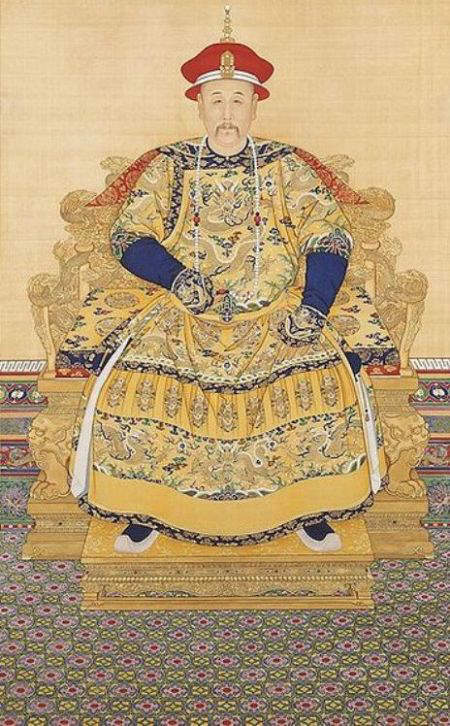
Emperor Yongzheng seated on his throne with ceremonial court dress including an identical Chaozhu.
The design of the necklace is linked to the Buddhist rosary, consisting of 108 beads in four segments of 27 beads each
The design of the necklace, linked to the Buddhist rosary is composed of 108 pearl beads in four sections of 27 beads each, separated by four large "Buddha head" beads, known as "fotou" made of red coral, flanked by pairs of blue lapis-lazuli. Apart from the main strand made up of white pearls, red coral and lapis-lazuli, there are three accessory strands attached to the main strand. These strands known as "jinian" strands, are made of turquoise beads, and attached to the necklace at points in the upper pearl segments. One "jinian" strand is attached to the upper left segment of 27 pearls, between the 7th and 8th pearl of the segment counting from top to bottom, dividing the segment into two sub-segments of 7 pearls and 20 pearls. The other two "jinian" strands are attached to the upper right segment of 27 pearls, between the 4th and 5th pearls and 9th and 10th pearls, dividing the segment into three sub-segments of 4 pearls, 5 pearls and 18 pearls. Each "jinian" strand is made up of 10 spherical blue turquoise beads, divided into two segments of 5 beads each, suspending a garden-egg shaped rubellite (red tourmaline) drop, surmounted by a gold bell-cap (calyx), and a white spherical pearl.
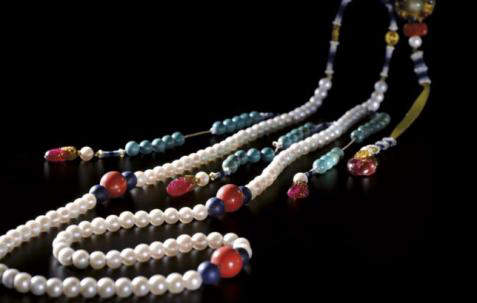
Yongzheng Emperor's Eastern Pearl Court Necklace and Turquoise Jinians
© Sotheby's
The yellow silk tape attached to the "fotou" at the back of the necklace, has a special design incorporated at its center and two ends. The design at the center is elaborate, consisting of a circular yellow gold plaque, mounted with a large, cabochon-cut, almost circular quartz, bezel-set in the center, surrounded by 4 cabochon-cut spinels and 4 cabochon-cut blue sapphires, placed alternately and also bezel-set on the yellow gold plaque. The reverse of the yellow gold plaque has a gold filigree design engraved on it. The gemstone-set, yellow gold plaque is flanked on either side by a pair of carved red coral beads and two white spherical pearl beads. The design is attached to the yellow silk tape on either side by yellow gold rings and hooks. The ends of the yellow silk tape to which the central design is attached, is given a blue and white banded appearance by wrapping with blue and white cords. Three white seed pearl bands are also placed at the middle of the white bands, on either side. At the point where the yellow silk band is attached to the "fotou" at the back, another white spherical pearl is placed, and the end of the yellow silk band is again banded with blue and white areas. The free end of the yellow silk band, also has the blue and white banding, followed by a white spherical pearl and a large garden-egg shaped rubellite (red tourmaline) suspended at the end by a bell-cap arrangement.

Close up of a section of Emperor Yongzheng's Ceremonial Eastern Pearl Court Necklace showing circular gold plaque mounted with gemstones.
© Sotheby's
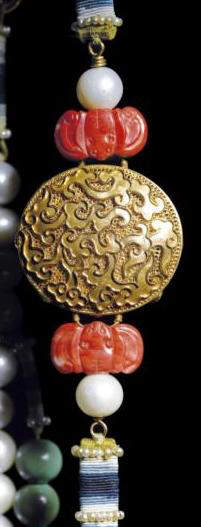
Close up of the reverse of the central yellow gold plaque.
© Sotheby's
Characteristics of the freshwater pearls in the necklace whose luster and brilliance had lasted for almost 300 years
Color of the pearls
The pearls are large, white, spherical or near-spherical, freshwater, Eastern pearls , known as "Dongzhu." The white color of the pearls is the most sought after color for pearls, and is caused by the absence of any colored pigments in the conchiolin part of the nacre, which allows the white color of aragonite (crystalline calcium carbonate) to show through.
Shape of the pearls
The shape of the pearls is spherical or near-spherical, the ideal shapes for pearl strands of this type. However, among natural pearls such shapes are extremely rare. Among freshwater pearls the occurrence of spherical and near-spherical shapes are rarer than in saltwater pearls. Most freshwater pearls are baroque in shape. Thus, the 108 natural spherical freshwater pearls used in this ceremonial necklace, must have been put together with great difficulty, handpicked from perhaps tens of thousands of freshwater pearls.
Size of the pearls
The diameter of the pearls vary from 9.60-10.65 mm, which is large compared to cultured Akoya pearls, and medium-sized compared to cultured South Sea pearls. The total weight of the necklace is 330 grams, which includes not only the weight of the pearls, but also all other gemstones associated with it such as corals, lapis-lazuli, turquoise, quartz, spinels, sapphires, rubellites (red tourmaline), seed pearls, as well as other materials such as yellow gold, yellow silk tape, blue and white cords etc.
The luster and orient of the pearls
The luster and orient of pearls are optical properties caused respectively by the reflection and refraction of light that fall on the pearls. The pearls are nacreous, having a luster and orient in keeping with freshwater natural pearls. Being natural, the pearls are made entirely of nacre. The color, luster and orient of the pearls, that depend on the thickness of nacre, are at a maximum level for these pearls, being composed entirely of nacre. It is for this same reason, that the pearls have been able to retain their color, luster and orient, despite the fact that they are 275-288 years old. Going by the beauty and brilliance of these nearly 300-years-old pearls, it can be safely predicted that their color, luster and orient will last for another 300 years or more, provided the necklace is preserved under the same conditions in which it existed for all these years.
The surface quality of the pearls
The pearls are said to be flawless, which obviously refers to the apparently perfect surface quality of the pearls. However, it is important to remember that pearls are creations of nature, and are not totally blemish-free. Even pearls that appear to be perfectly flawless, may have blemishes that are not visible to the naked eye. Thus, the reference to blemish-free surface in the grading of pearls, always means apparently blemish-free.
History of the Yongzheng's ceremonial court necklace
History of the usage of freshwater pearls
Exploitation of Scottish freshwater pearls
Freshwater pearls have been valued and appreciated as much as saltwater pearls since very ancient times. It is a well-known fact that Julius Caesar invaded Britain in 55 B.C. to take control of the trade in Scottish freshwater pearls, which together with gold, underpinned the Roman monetary system. In the 16th-century commercial exploitation of freshwater pearls in Scotland had developed into a large scale industry, and large quantities of Scottish pearls entered the crown jewels of both England and Scotland. Mary, Queen of Scots is reported to have removed a necklace made of Scottish freshwater pearls before kneeling to meet the headsman's axe. The species of freshwater mussel that produced Scottish pearls, was the Unionoidae mussel, Margaritifera margaritifera, commonly found in the northern temperate regions of the world.
Exploitation of freshwater pearls in North America
In North America native Indians of the Atlantic coastal areas, and the Mississippi River Basin had exploited freshwater mussels for several millennia not only as a source of food, but also for their shells and occasional pearls, used as ornaments. The colorful and iridescent mother-of-pearl was transformed into pieces of ornamental jewelry such as necklaces, pendants, armlets etc. Freshwater pearls were incorporated into pieces of jewelry such as pendants and ear-pendants, worn both by males and females. Pearls were also used to pay tribute to tribal chiefs. Powhattan, father of Pocahonta is reported to have had large collections of pearls received as tribute from his subjects.
The Mississippi River basin in North America, is still the World's richest habitat for freshwater mussels, containing almost 300 different species of freshwater mussels out of 1,000 species identified worldwide. In recent times the first freshwater pearl discovered in North America is the 93-grain pink pearl discovered by a carpenter named Jacob Quackenbush, in 1857, in the streams of Notch Brook, near Paterson City, New Jersey, that came to be known as the Paterson Pearl, which was purchased by Charles L. Tiffany for $1,500, and later sold in Paris to a French dealer for $2,500, who in turn sold it to the Empress consort of Napoleon III, Eugenie de Montijo, and thus came to be known as the "Queen Pearl." The discovery of the "Paterson Pearl" in 1857, triggered a "pearl mania" in New Jersey, that did not spare any freshwater bodies in the State, both running and still water, such as streams, rivers, ponds, lakes and reservoirs, in search of freshwater mussels, that may harbor the elusive pearl. In the year 1857, it was reported that the New York City market, received about $15,000 worth of pearls from the waters of Notch Brook alone. The fever also spread to other neighboring states, such as New York, Ohio, Texas, Arkansas, Wisconsin, Mississippi, Kentucky, Illinois, and Tennessee, and significant quantities of freshwater pearls were discovered. Out of around 130 species of freshwater mussels found in the Mississippi River basin, only around 20 species were commercially harvested for their
The discarded freshwater mussel shells became the raw material for a booming new industry in the Midwestern states, the manufacture of shell buttons
The pearl rush lasted into the early 1900s, and the seemingly endless supply of freshwater mussel shells, became the basis of a booming industry in the Midwest, the mother-of-pearl button industry, whose capital was Muscatine, Iowa. In the year 1912, around 200 button manufacturing plants had been set up in the Midwestern States of the United States, that made use of mother-of-pearl shells from the freshwater mussels. Any freshwater pearls produced from the mussels harvested was only a by product of this industry. The invention of plastic buttons in the 1940s killed off the Midwestern pearl button industry, that was good news for the freshwater mussels threatened with extinction. The populations of freshwater mussels in the Mississippi River basin began recuperating until the 1950s, when Japanese scientists discovered that the freshwater mussel shells of the United States, were the most suited for producing bead nuclei for the Japanese cultured pearl industry. This led to the revival of the freshwater mussel fishery in the United States to supply the Japanese pearl culturing industry. Out of around 130 species of freshwater mussels found in the Mississippi River basin, only around 20 species were commercially harvested for their shells and pearls if any. All these species belong to the family Unionoidae, such as Fusconaia ebena (ebony shell), Megalonaias nervosa (washboard), Potamilus alatus (heel splitter) etc.
Exploitation of freshwater pearls in Ancient China
Another civilization where pearls had been used and appreciated since ancient times, is the ancient Chinese civilization. According to ancient Chinese texts originating from around 2,000 B.C. freshwater pearls were harvested from mussels that lived in the River Hwai. China also had a vibrant marine pearl fishery, off the Leizhou Peninsula and northern Hainan Island just east of Vietnam, that remained active from at least the 1st century B.C. to the 17th-century A.D. that produced large quantities of pearls of medium size and quality, originating from a species of Pinctada, similar to the Sri Lankan and Persian Gulf oyster, Pinctada radiata. An indication of the usage and appreciation of pearls in China comes from around the period 500 A.D. when Chinese pearl enthusiasts placed tiny molds of Buddha images inside freshwater Cockscomb Pearl Mussels (Cristaria plicata), between the mantle and the shell, and created Buddha blister pearls, the world's first cultured pearls.
The usage of freshwater pearls in China reach a climax during the rule of the Qing or Manchu dynasty, from 1644 to 1911
However, the usage of freshwater pearls in China reached a climax only after the 17th-century during the rule of the Qing or Manchu dynasty, which ruled China from 1644 to 1911. The Manchu rulers loved Eastern pearls, freshwater pearls originating from the Manchu homeland in northeastern China, from the rivers of Sungari, Yalu and Amur in Manchuria. As the pearls were closely associated with the Manchu homeland, only members of the Imperial clan were permitted to use them. They were used in hat ornaments and necklaces. The Emperor's hat finial for formal occasions was tall and had a three-tiered arrangement of 15 pearls set in gold. The hat finial for semiformal occasions was set only with a single large Eastern pearl. Other male members of the Imperial family, were entitled to fewer pearls in shorter tiered arrangement, and a ruby or other red jewel for semiformal wear. The Emperor also wore strands of Eastern pearls as a court necklace or "Chaozhu" for formal occasions, as well as rituals conducted at the Altar of the Moon. Smaller freshwater pearls were incorporated in women's earrings and neckpieces and were also used on formal court robes, to outline borders. The use of myriads of seed pearls in embroidery of court robes was also a part of the Manchu tradition. Thus, Manchu rulers of the Qing dynasty valued natural Chinese freshwater pearls from the rivers of Manchuria, more highly than the saltwater pearls produced off the Leizhou Peninsula.
The source of the freshwater pearls in the necklace
Eastern pearls originated in the northeastern region of China, known as Manchuria
The freshwater pearls in the necklace are known as "Eastern pearls." This is a reference to the region of origin of the pearls in China - northeast China - the region known as Manchuria, the homeland of the Manchu rulers of the Qing dynasty. The actual source of the pearls in Manchuria, were the freshwater bodies in the region such as rivers, streams, ponds and lakes. Three rivers in Manchuria, Songhua (Sungari), Yalu and Heilong (Amur, Shaliyan Ula) were three of the main sources of freshwater pearls during this period. Out of these rivers the Heilong Jiang (Chinese) river or Sahaliyan Ula (Manchu) river or Amur (Russian) river, is the 9th longest river in the world with a length of 2,824 km.
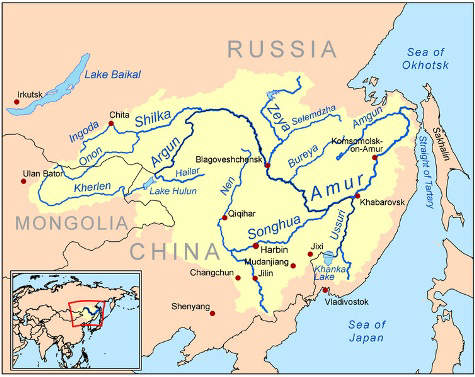
Amur River and its main tributary Songhua.
Photo: Kmusser C.C
The Heilong Jiang or Shaliyan Ula or Amur river
The Heilong Jiang river rises from the hills of western Manchuria at the confluence of its two major affluents, the Shilka river and Arjun river, and flows east, forming the border between the Russian Far East and Northeastern China (Inner Manchuria). The river receives many tributaries on its long journey to the Strait of Tartary, such as the Huma river at Huma, the Zeya river, the Bureya river, the Songhua river at Tongjiang, the Ussuri river at Khabarovsk, after which the river ceases to define the Russia-China border. The river now flows through Russian territory in a northeasterly direction, and receives its last tributary the Amgun river, before flowing into the sea at the Strait of Tartary. Lands east of the Ussury and the lower Amur was acquired by Russia in 1860, by the Convention of Peking. Presently Manchuria is divided into two political entities, Outer Manchuria under Russian control and Inner Manchuria under Chinese control. The dividing line between the two Manchurias, is the Amur river that roughly runs in the east-west direction and the Ussury river that runs in the north-south direction, meeting the Amur at Khabarovsk. In the 18th century at the time of Yongzheng's rule (1722-35), Manchuria was an undivided region belonging to China's northeastern region.
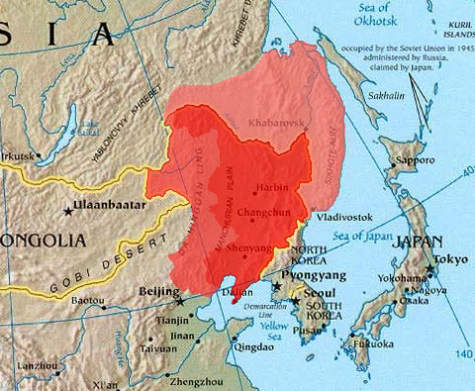
Outer Manchuria (light red) and Inner Manchuria (dark red & medium red)
The Songua river
The Songua river (Sungari), meaning White river in Manchu language, which was also famous for its freshwater mussels is the largest tributary of the Heilong or Amur river, originating from the Changbai mountains, and flowing a distance of about 1,434 km through the Heilong Jiang and Jilin provinces, before joining the Heilong or Amur river at Tongjiang. The river freezes during winter, from November to March, and has its highest flow, when the mountain snow melts during the spring thaw.
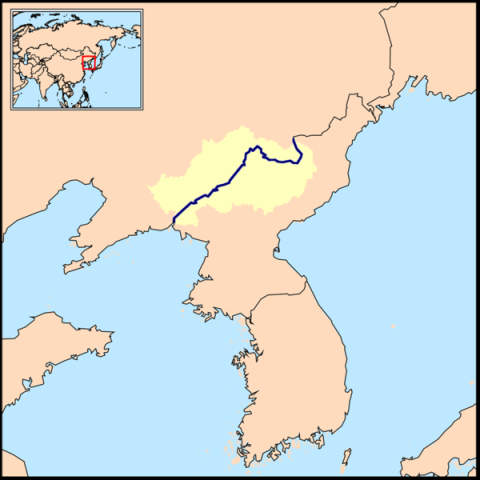
Yalu River, border between North Korea and Manchuria, China.
Photo: Kmusser C.C

Landsat Satellite Image of Yalu river and Korea Bay.
The Yalu river
Apart from the Heilong Jiang (Amur) river and its many tributaries, such as the Songua, Huma, Zeya, Bureya, Ussuri and Amgun, that constitute the main habitat of the freshwater mussels, there is another important river in the southeast of Manchuria, that forms the natural border between northeastern China and North Korea. This is the Yalu river, which is 790 km (491 miles) long, and originates in the Baitou Mountain, 2750 meters (9,000 feet) above sea level. The river winds southwards to Hyesan in North Korea, changes course to the northwest for 130 km (80 miles) up to Lingjiang, then turns to flow southwestward for 320 km (200 miles) to empty into Korea Bay in the Yellow Sea at Sinuiju. The main tributaries of Yalu river are Herchun and Changjin rivers.
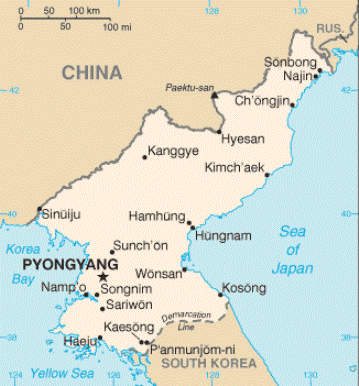
Map of North Korea showing Yalu river border between North Korea and Manchuria from Hyesan to Sinuiji
The freshwater pearl fishery of Manchuria as described by George Frederick Kunz in his book, The Book of the Pearl
Pearls are yet found in the river mussels in all parts of Eastern Asia, from Siberia to the Indian Ocean, and from the Himalayas to the Pacific. It is represented that they are not from the Unio margaritifera, the common river mussel of Europe, but from other species, such as Unio mongolicus, Unio dahuricus, Dipsas plicatus, etc.It is quite impossible to obtain a reliable estimate of the total number of persons employed, or the output of pearls in China, but these items are certainly very much larger than the average occidental believes.
In the vicinity of Canton the Dipsas plicatus has been used for centuries by the Chinese in the production of artificial pearls, this industry giving employment to thousands of persons.
The pearl-mussel fishery is of importance in Manchuria, where it has been carried on for hundreds of years, not only by the citizens, but by the military department on account of the government, and especially in the streams which flow into the Songari, a tributary of the Amur. Jacinth relates that in case of a deficit, the officers and subalterns were punished by a deduction from their pay, and also by corporal chastisement. Witsen speaks of the pearls from the River Gan, a tributary of the Amur, and also from the islands of the Amur, the boundary river of Manchuria. Pearl fisheries were established at these places by the Russians nearly two centuries ago.
Pearls become finer and more plentiful the further we penetrate into Manchuria; and they are numerous in the lake of Heikow or Hing-chou-men, "Black Lake" or "Gate of Precious Gems," where they have long been exploited. for the account of the emperor of China.
The species of freshwater mussels from which Manchurian freshwater pearls most probably originated ?
The species of mussels from which the Manchurian freshwater pearls incorporated in the ceremonial court necklace originated is not known exactly, but according to Kunz some of the freshwater mussel species found in Eastern Asia at that time were Unio mongolicus, Unio dahuricus and Dipsas plicatus. These scientific names of course would have undergone changes over the years. The common river mussel of Europe previously known as Unio margaritifera is now known as Margaritifera margaritifera. Dipsas plicatus the species used by the Chinese for centuries in the production of artificial pearls, such as the Buddha blister pearls, is now Known as Cristaria plicata, whose common name is Cockscomb pearl mussel. The modern name for Unio mongolicus and Unio dahuricus is not known, but one of these species may well be the the Triangle shell Pearl Mussel, known as Hyriopsis cumingi, which ranges naturally in China and Japan, and has been used in freshwater pearl culture in both countries with astonishing results. The freshwater pearl culturing industry in China today is based on Hyriopsis cumingi, and the pearls produced by them rival saltwater pearls in luster, color range and availability. Some of the colors produced in these pearls are white, pink, lavender and deep rose. In contrast, cultured pearls produced by Cristaria plicata, the first indigenous freshwater mussel used in modern pearl culturing in China, were of poor quality and were known as "rice crispies." The Chinese pearl culturists were tempted to use Cristaria plicata for culturing freshwater pearls initially, because the species was tested and trusted, used by their ancestors for centuries in culturing Buddha blister pearls.
Other ceremonial court necklaces (chaozhu) made of Eastern pearls
Ceremonial court necklaces (chaozhu) were designed with a variety of precious and semi-precious materials, such as blue tourmaline and coral chaozhu (Lot No. 44, Christie's London auction 7762), walnut bead and porcelain chaozhu (Lot No.42, Christie's London auction 7621) etc. Such chaozhu are found in important museums and private collections. However chaozhu made of "dongzhu" or Eastern pearls are extremely rare. In China, the land where these court necklaces were produced during the rule of the Qing dynasty, there are only five other known chaozhu made of Eastern pearls, all of which are located in the Palace Museum in Beiging. One of these necklaces belong to the mid-17th century, from 1650 to 1661, the period of rule of Emperor Shunzi of the Qing dynasty, and is older than the Yongzheng Emperor's court necklace by around 70 years. The other four chaozhu in the museum all belong to the 19th century, from the period of rule of Emperor Jiaqing to that of Emperor Guangxu. It is believed that there is a sixth chaozhu in the Shenyang Palace Museum. Eastern pearl chaozhu are so scarce that even the National Palace Museum in Taiwan does not own one.

Blue Tourmaline and Red Coral Chaozhu
© Christie's

Walnut and Porcelain Chaozhu
© Christie's
Rules relating to the Imperial wardrobe of emperors of the Qing dynasty
The manuscript "Huangchao liqi tushi" written during Emperor Dorgon's period of rule, laid down all the guidelines for the ceremonial paraphernalia of the emperor and his court
The Qing dynasty was founded in 1616 under the name "Jin dynasty" by Nurhaci, a Manchu of the Aisin-Gioro Clan. Nurhaci's son Hung Taiji who succeeded his father in 1626, changed its name to "Qing" in 1636. However, it was only in 1644 the Qing dynasty was able to capture power in China, and succeed the Ming dynasty, during the reign of Dorgon. Thus, Emperor Dorgon (Chengzong) is actually the first emperor of the dynasty, who assumed the title, Emperor of China. It was Hung Taiji, who was also known as Abahai, who drew up the earliest basic rules relating to the Imperial wardrobe in 1636, as to what the emperor should wear on different occasions, and the code of dressing for members of his court and the Imperial clan. However, after Emperor Dorgon became the Emperor of China in 1644, the dress code of Abahai was revised and expanded, and the new set of regulations were recorded for future use by emperors of the Qing dynasty, in a manuscript titled in Chinese as "Huangchao liqi tushi" which translated into English means, "Illustrated Regulations for the Ceremonial Paraphernalia of the Qing Dynasty." The manuscript that included thousands of illustrations and lengthy text laid down all the required guidelines for the ceremonial paraphernalia of the emperor and his court. Detailed dress codes for men and women, including costume and jewelry, from the emperor down through all the ranks of the Imperial clan, and the entire court and civil service are laid down in this detailed manuscript.
Only the emperor and his family members were allowed to wear the precious Eastern pearls, that were designed into pieces of jewelry like necklaces or embroidered on the royal robes
Apart from the emperor's dress, accessories such as jewelry worn by the emperor are meticulously documented, that prescribed four necklaces of different colors to suit the different types of occasions the emperor had to attend. According to this the emperor's principal chaozhu, should be made of "dongzhu" or Eastern pearls from Manchuria, the homeland of the Manchu rulers of the Qing dynasty. Eastern pearls were treasured by the Manchu rulers because of their association with their homeland. The rules laid down in the manuscript, allowed only the emperor and his family members to wear the precious Eastern pearls, that were transformed into necklaces or sewn on to the Imperial robes. When Rongxian, the daughter of Emperor Kangxi - the 3rd emperor of the Qing dynasty of China, who ruled between 1661 and 1722 - was given in marriage to Prince Wuergan in 1691, part of her dowry included a "jifu" (royal robe) made of yellow silk decorated with dragon motifs, embroidered with 100,000 Eastern pearls. An Eastern pearl embroidered dragon robe belonging to Emperor Qianlong, the 5th emperor of the Qing dynasty, who ruled between 1735 and 1796 is now part of the collection of the Capital Museum in Beiging.
Even the design of the emperor's chaozhu was specified in the royal manuscript
The royal manuscript also gave the specifications for the design and assembly of the emperor's chaozhu. According to these specifications, the chaozhu should include 108 pearl beads, divided into four segments of 27 pearl beads each, separated by a bead of different color and material, called a "fotu" (Buddha's head). Three additional pearl strands called "jinian" arise as appendages from the two upper segments of the chaozhu. A central decorative strap is attached to the "fotu" at the back. The use of materials in Emperor Yongzheng's ceremonial necklace or chaozhu, such as Eastern pearls, red corals as "fotu" flanked by lapis lazuli, turquoise for "jinian" strings. also appears to be specified in the manuscript. The crown prince was allowed to use any semi-precious stone beads, strung with apricot-yellow thread, while the emperor's other children were permitted to use amber with golden-yellow strings, and all others belonging to the court could use any bead made of stones, glass, porcelain, walnut or other suitable material, strung with black thread.
Emperor Yongzheng's ceremonial pearl court necklace is put up for sale at Sotheby's Hong Kong auction on April 8, 2010, by its anonymous owner
Emperor Yongzheng's 18th-century Ceremonial Eastern Pearl Court Necklace or Chaozhu was put up for auction by its anonymous owner at the Sotheby's Hong Kong auction, titled "Fine Chinese Ceramics & Works of Art Sale" held on Thursday, April 8, 2010. at the Hong Kong Convention and Exhibition Center. The sale also included several other Chinese Imperial treasures from the period of the Qing dynasty. The necklace is said to have come from a reputed Japanese collection, characterized by Sotheby's as the "Property of a Gentleman" and was accompanied by a report, bearing No.0911002, from the Gubelin Gem Lab, Switzerland, certifying that the pearls incorporated in the necklace were "natural freshwater pearls." The necklace which was Lot No. 1813, on the catalogue was referred to as "A Very Important And Magnificent Imperial Pearl Court Necklace (Chao Zhu) - Qing Dynasty, 18th Century." A pre-sale estimate of HK$ 8-12 million equivalent to US$ 1-1.5 million was placed on the necklace.
Emperor Yongzheng's Ceremonial Pearl Court Necklace sets a new world record for the highest price realized by a natural pearl necklace at an auction, and the highest price ever realized by a natural freshwater pearl necklace
The auction sale of the rare and unique necklace generated much enthusiasm among prospective bidders. After a keenly contested bidding process, that consisted of 61 bids, the hammer was finally brought down in favor of an anonymous telephone bidder. The final price realized for the necklace, astonished everyone assembled at the auction, bidders, auctioneers, spectators, and journalists alike. The price of HK$ 67.86 million, equivalent to US$ 8.7 million realized, was more than 8 times the lower pre-sale estimate and almost 6 times the upper pre-sale estimate, and was the highest price ever paid for a natural pearl necklace at an auction. The price of US$ 8.7 million, broke the previous record set by the double-strand Baroda Pearl Necklace in April 2007, at a Christie's auction in New York, which fetched US$ 7.1 million. Emperor Yongzheng's Ceremonial Pearl Court Necklace, also set a new world record for the highest price ever paid for a natural freshwater pearl necklace. It is rather ironic that in a world where natural saltwater pearls always fetched the premium prices when compared to natural freshwater pearls, a natural freshwater pearl necklace has set the world record for the highest price ever realized by a natural pearl necklace at a public auction.
Commenting on the record price realized by the necklace, Nicholas Chow, head of Sotheby's China Department, said,"The price today was a record for imperial jewelry. There's not been a single piece of imperial jewelry that can even approach it in price. It is many, many multiples by many times a world record. It's got great significance. It's something that the emperor treasured. It sort of marks a very important moment in his life, and this is why this is something that can easily capture our clients imagination.
Table showing some pearl necklaces that fetched record-breaking prices at auctions conducted by leading auction houses
| S/N | Name of Pearl Necklace | Auction Date |
Auction House |
Price Realized |
| 1 | Barbara Hutton / Marie Antoinette Pearl Necklace | Nov. 1999 | Christie's Geneva | US$ 1.47 million |
| 2 | Double Strand Pearl Necklace of unknown provenance | Nov. 2004 | Christie's Geneva | US$ 3.1 million |
| 3 | Duchess of Windsor Single-strand Pearl Necklace | Dec. 2007 | Sotheby's New York | US$ 3.6 million |
| 4 | Double-strand Baroda Pearl Neckace | April 2007 | Christie's New York | US$ 7.1 million |
| 5 | Emperor Yongzheng's Ceremonial Pearl Court Necklace | April 2010 | Sotheby's Hong Kong | US$ 8.7 million |
Other Chinese Imperial treasures from the Qing dynasty that fetched record-breaking prices at the auctions
Apart from the Emperor Yongzheng's ceremonial pearl court necklace that set record-breaking prices at this historic auction, there were several other Chinese Imperial treasures from the same period, belonging to the Qing dynasty, that also set very high prices.
One such piece was the "Tai Shang Huang Di" White Jade Seal belonging to the period of Emperor Qianlong which fetched a price of HK$ 95.86 million, equivalent to US$ 12.29 million, which was a new world record for a jade seal. The previous world record for a jade seal was US$ 5.9 million set in 2007, also at a Sotheby's auction.
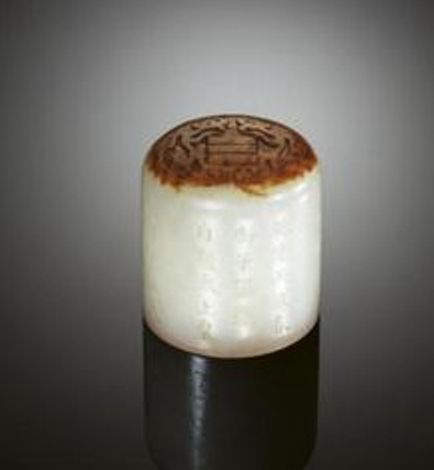
Emperor Qianlong's "Tai Shang Huang Di" White Jade Seal
© Sotheby's
Another piece was an outstanding and extremely rare three-tiered Beijing enameled box also from the period of Emperor Qianlong that sold for HK$ 27.54 million, equivalent to US$ 3.53 million.
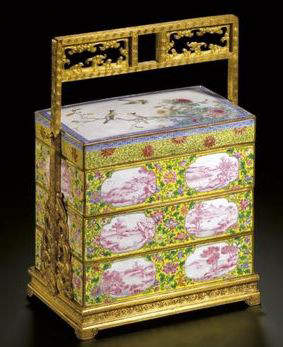
Three-tiered Beijing enameled box from the Qianlong period
© Sotheby's
A carved bamboo and ruyi-sceptre, belonging to the Qianlong period, and inscribed with a poem by the emperor in kaishu script on the underside of the lingzhi head was sold for HK$ 15.78 million, equivalent to US$ 2million.
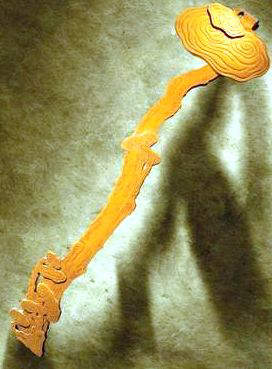
A carved bamboo and ruyi-sceptre
© Sotheby's

Kaishu script poem by Emperor Qianlong on the underside of the lingzhi head
© Sotheby's
The Imperial Zitan throne also of the Qianlong period sold for HK$85.78 million, equivalent to US$ 10.99 million, a world auction record for any Chinese furniture.
A Ming dynasty pair of carved-marble lions sold for HK$ 21.9 million, equivalent to US$ 2.81 million.
The auction titled "Fine Chinese Ceramics & Works of Art" included antiques and paintings, and had 2,400 items on offer during the packed 5-day sale. The total turnout at the auction was HK$ 2 billion equivalent to US $258 million, which was HK$ 0.7 billion higher than the company's estimate of HK$ 1.3 billion. 40% of the total sale output came from antiques, which also included Chinese imperial treasures. The bidders were mainly mainland Chinese, and Indonesians. There was fierce bidding from the mainland Chinese not only for older works of art but also for contemporary works of art. An equivalent sale held last year during the height of the recession realized only HK$691 million. The phenomenal increase in sales is taken as an indication of global economic recovery. Hong Kong's $500 million-a-year art auction market seems to have achieved a recovery, led by mainland Chinese, who competed with their U.S. rivals for the most valuable items. The great interest shown by Chinese investors in art and other forms of investment have been attributed to the unrealistic increases in prices of property and stocks, in which they normally invest. Both auction houses, Sotheby's and Christies have registered record sales in Hong Kong, and officials of the two auction houses agree that Hong Kong is now the third largest auction location in the world, after New York and London, the 1st and 2nd locations.
Yongzheng Emperor - A short biography
His early life and rise to the position of a First Class Prince
Emperor Yinzhen, who took the era title, "Yong-zheng," meaning "harmonious justice" after he ascended the throne of China in December 1722, was the 6th emperor of the Manchu Qing dynasty and the 4th emperor of the dynasty to rule over China proper. Yinzhen, who was born on December 13, 1678, was the 4th son of Kangxi Emperor by his consort, Empress Xiao Gong Ren. Yinzen was the Empress' eldest son. Even though the children of the royal family were given a strict education by royal tutors, they were exposed to the outside world from an early age, that helped them to appreciate the realities of life outside the palace. Yongzheng accompanied his father on several inspection tours around Beijing, and at least on one trip further south. Yongzhen was made the honorary leader of the Plain Red Banner during Emperor Kangxi's second battle against the Mongol Khan Gordhun, and was made a "beile" (Lord) in 1689, and eventually rose to become a second class prince in 1698. His greatest challenge came in 1704, when Emperor Kangxi who had faith in his capabilities, dispatched him to southern China together with his 13th son, Yinxiang to co-ordinate relief efforts after the massive flooding caused by the overflowing of the mighty rivers Yangtze and Yellow Rivers, following a severe deluge. Yongzheng was able to augment the meager relief fund provided by the government, with funds generated by mobilizing the wealthy businessmen of the South, and was thus able to avert a famine, and help the people to resettle within a short period of time. His great qualities of hard work, efficiency, honesty and incorruptibility were brought to the fore by this daunting assignment, that the Emperor immediately gave him the peerage title of "Prince Yong" meaning "First Class Prince" on his arrival in Beiging in 1709.
Emperor Kangxi picks the 4th Imperial prince Yongzheng as his successor to the Chinese Imperial throne
The Kangxi Emperor had 14 sons by his several consorts, and therefore 14 aspirants to his throne. Initially he appointed his eldest son and later his second son as Crown Prince, but both of them were subsequently removed and imprisoned. After the removal of his second son as Crown Prince, he left the position vacant, that led to further intrigues, and his court deeply divided between at least four aspirants to the throne, the 3rd, 4th, 8th and 14th Imperial Princes. Yongzheng was the 4th Imperial Prince, and a leading contender to the throne. Kangxi Emperor, who had ruled his vast domain for 60 years and was now nearing his end, had already made his choice as to who his successor should be, which was written in his last will. On December 20, 1722, the ailing king summoned seven of his sons and the Commandant of the Beijing Gendarmerie, Longkodo to his bedside. Longkodo was asked to read his last will, in which the king declared that Yinzhen would succeed him on the Imperial throne.
Emperor Yongzheng consolidates his position as the absolute ruler of the Chinese Empire
Yongzheng who was very close to his father was devastated by his death, yet he lost no time in consolidating his position as the new emperor. He made an effort to reconcile with his siblings after the bitter contest for the throne. His first official act as emperor was to release his brother and ally, the 13th prince Yinxiang, who assisted him in the relief effort during the major floods, and who was imprisoned by his father, Emperor Kangxi, for aligning himself with the crown prince who worked against him. Prince Yinxiang immediately put together a force drawn from the Fengtai command who took control of the Forbidden City and its environs, to forestall any attempt of take over by the 8th prince Yinsi's cronies. However, Yongzheng reconciled with his brother Yinsi, when he appointed him to the new Governing Council, the other members of the council being, Yinxiang, Longkodo, Ma Qi and Zhang Tingyu. Yongzheng also gave his two brothers the highest titles, Yinsi being given the title Prince Lian and Yinxiang the title Prince Yi. They held the highest positions in the land after the king. However, Yinsi eventually became a traitor to Yongzheng, and he and the 9th prince Yintang were arrested and imprisoned for supporting the 14th prince Yinti's aspirations to the throne. Later some of the trusted generals Nian Gengyao and Longkodo also fell out of favor with the king, the former committing suicide, and the latter dying while under house arrest.
Emperor Yongzheng's rule was a period of peace and prosperity to the Nation
Yongzheng eventually turned out to be the absolute ruler of China, having eliminated all potential threats to his rule. He is noted for adopting an autocratic style of rule. From his young days he was respected for his honesty. He disliked corruption, and hated corrupt officials, giving the maximum punishment whenever they were found guilty. He also cracked down on drug abuse, and issued an edict in 1729, prohibiting the smoking of madak, a blend of tobacco and opium. He transformed his empire into one of the greatest powers in Asia, with total internal peace and harmony, that paved the way for greater economic growth and development, and expansion of commerce and international trade. The period also marked the revival of the arts and learning. During his period the treasury reserves almost doubled from 32 million taels to 60 million taels, within a period of 9 years from 1721 to 1730. The greatest drain on the treasury was military expenditure involved in defending the borders, maintaining a military presence in Mongolia and Tibet, and suppressing rebellions by dissatisfied tribes like the Dzungars.
Emperor Yongzheng's rule lasted only 13 years, and he was succeeded by his son Emperor Qianlong
Unlike his father, Emperor Kangxi who ruled for 61 years, Emperor Yongzheng's rule was relatively short and lasted only 13 years. He died in 1735 at the age of 58 years. The cause of his death was either due to overwork or complications that set in due to overdose of medication which he believed would prolong his life. He had 14 children from his empresses and concubines, but only five survived into adulthood. His son Prince Bao succeeded him as the 5th emperor of the Qing dynasty to rule China, under the era name of Qianlong. Coincidentally Emperor Qianlong's rule like his grandfather Emperor Kangxi's rule was prolonged, and also lasted 61 years, until 1796.
You are welcome to discuss this post/related topics with Dr Shihaan and other experts from around the world in our FORUMS (forums.internetstones.com)
Related :-
External Links :-
1) Sotheby's Hong Kong Sale 0323 - Lot 1813, A Very Important and Magnificent Imperial Pearl Court Necklace. https://www.sothebys.com/app/live/lot/LotDetail.jsp?lot_id=159589380
References :-
1) Sotheby's to Sell Pearl Necklace Owned by Yongzheng Emperor in Hong Kong in April 2010 - Mastoloni, the most beautiful pearls in the world. www.mastoloni.com
2) Sotheby's Hong Kong Sale Raises $258 million on Global Growth - Le Min Lim. www.bloomberg.com/news
3) A Tourmaline and Coral Court Necklace, Chao Zhu - Christie's London Auction, November 3, 2009. Sale 7762. www.christies.com/lotfinder
4) A Walnut And Porcelain Court Necklace, Chao Zhu - Christie's London Auction, November 4, 2008. Sale 7621. www.christies.com/lotfinder
5) List of Emperors of the Qing Dynasty - From Wikipedia, the free encyclopedia
6) Yongzheng Emperor - From Wikipedia, the free encylopedia.
7) Songhua River - From Wikipedia, the free encyclopedia.
8) Amur River - From Wikipedia, the free encyclopedia.
9) Manchuria - From Wikipedia, the free encylopedia.
10) Sotheby's Hong Kong Sale 0323 - Lot 1813, A Very Important and Magnificent Imperial Pearl Court Necklace. www.sothebys.com
11) Freshwater Pearls - Chinese Pearl Mussels - www.amnh.org
12) Pearls Without Price : The Rise And Fall Of A Sometimes-Precious Gem - by Bennet Bronson. Speech delivered to the Chicago Literary Club, April 10, 2000. www.chilit.org
13) The History of Pearls - www.touchofpearls.com
14) Silks for Thrones and Altars -
Chinese Costumes and Textiles - By John E. Vollmer
Powered by Ultra Secure
Amazon (USA) Cloud Network

Founder Internet Stones.COM
Register in our Forums
| Featured In
|
|
|
|
|
|
|
|


















